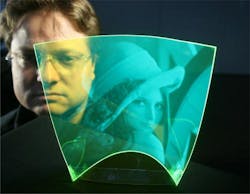Transparent, flexible image display uses luminescent concentrator film
Washington, DC--An Optics Express paper describes a new way of capturing images based on a flat, flexible, transparent, and potentially disposable polymer sheet. "To our knowledge, we are the first to present an image sensor that is fully transparent--no integrated microstructures, such as circuits--and is flexible and scalable at the same time," says Oliver Bimber of the Johannes Kepler University Linz in Austria. The new imager uses fluorescent particles to capture incoming light and channel a portion of it to an array of sensors framing the sheet. With no electronics or internal components, the imager’s elegant design makes it ideal for a new breed of imaging technologies, including user interface devices that can respond not to a touch, but merely to a simple gesture.
The sensor is based on a polymer film known as a luminescent concentrator (LC), which is suffused with tiny fluorescent particles that absorb a very specific wavelength (blue light for example) and then reemit it at a longer wavelength (green light for example). Some of the reemitted fluorescent light is scattered out of the imager, but a portion of it travels throughout the interior of the film to the outer edges, where arrays of optical sensors (similar to 1-D pinhole cameras) capture the light. A computer then combines the signals to create a gray-scale image. "With fluorescence, a portion of the light that is reemitted actually stays inside the film," says Bimber. "This is the basic principle of our sensor."
For the luminescent concentrator to work as an imager, Bimber and his colleagues had to determine precisely where light was falling across the entire surface of the film. This was the major technical challenge because the polymer sheet cannot be divided into individual pixels like the CCD camera inside a smartphone. Instead, fluorescent light from all points across its surface travels to all the edge sensors. Calculating where each bit of light entered the imager would be like determining where along a subway line a passenger got on after the train reached its final destination and all the passengers exited at once.
The solution came from the phenomenon of light attenuation, or dimming, as it travels through the polymer. The longer it travels, the dimmer it becomes. So by measuring the relative brightness of light reaching the sensor array, it was possible to calculate where the light entered the film. This same principle has already been used in an input device that tracks the location of a single laser point on a screen. The researchers reconstruct the image by using a technique similar to X-ray computed tomography, more commonly known as a CT scan.
"In CT technology, it's impossible to reconstruct an image from a single measurement of X-ray attenuation along one scanning direction alone," says Bimber. "With a multiple of these measurements taken at different positions and directions, however, this becomes possible. Our system works in the same way, but where CT uses X-rays, our technique uses visible light."
Currently, the resolution from this image sensor is low (32 × 32 pixels with the first prototypes). The main reason for this is the limited signal-to-noise ratio of the low-cost photodiodes being used. The researchers are planning better prototypes that cool the photodiodes to achieve a higher signal-to-noise ratio.
The main application the researchers envision for this new technology is in touch-free, transparent user interfaces that could seamlessly overlay a television or other display technology. This would give computer operators or video-game players full gesture control without the need for cameras or other external motion-tracking devices. The polymer sheet could also be wrapped around objects to provide them with sensor capabilities. Since the material is transparent, it's also possible to use multiple layers that each fluoresce at different wavelengths to capture color images.
The researchers also are considering attaching their new sensor in front of a regular, high-resolution CCD sensor. This would allow recording of two images at the same time at two different exposures. "Combining both would give us a high-resolution image with less overexposed or underexposed regions if scenes with a high dynamic range or contrast are captured," Bimber speculates. He also notes that the polymer sheet portion of the device is relatively inexpensive and therefore disposable. "I think there are many applications for this sensor that we are not yet aware of," he concludes.
Click here for the Optics Express paper entitled "Towards a transparent, flexible, scalable and disposable image sensor using thin-film luminescent concentrators."
SOURCE: OSA; http://www.osa.org/en-us/about_osa/newsroom/newsreleases/2013/new_imaging_device_that_is_flexible,_flat,_and_tra/
About the Author

Gail Overton
Senior Editor (2004-2020)
Gail has more than 30 years of engineering, marketing, product management, and editorial experience in the photonics and optical communications industry. Before joining the staff at Laser Focus World in 2004, she held many product management and product marketing roles in the fiber-optics industry, most notably at Hughes (El Segundo, CA), GTE Labs (Waltham, MA), Corning (Corning, NY), Photon Kinetics (Beaverton, OR), and Newport Corporation (Irvine, CA). During her marketing career, Gail published articles in WDM Solutions and Sensors magazine and traveled internationally to conduct product and sales training. Gail received her BS degree in physics, with an emphasis in optics, from San Diego State University in San Diego, CA in May 1986.
